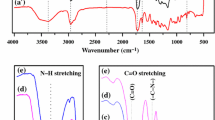Abstract
The relationship between the chemical structure and physical properties of ultra-violet cured isophorone diisocyanate (IPDI) and toluene diisocyanate (TDI) based urethane acrylates were studied. The two systems were prepared with varying soft-segment molecular weight and cross-linker content. Dynamic mechanical test results show one-phase or two-phase materials may be obtained depending on the soft-segment molecular weight. With increasing soft-segment molecular weight, the polyol glass transition shifts to lower temperatures. Increasing the cross-linker content using either N-vinylpyrrolidone (NVP) or polyethyleneglycol diacrylate (PEGDA) causes an increase in Young's modulus and ultimate tensile strength. Cross-linking with NVP causes an increase in toughness in the two-phase materials and shifts the high-temperature glass transition peak to higher temperatures. In contrast, an increase in PEGDA content does not improve the toughness of the two-phase materials or affect the position of the high-temperature glass transition peak. Comparison of the tensile properties of the TDI- and IPDI-based systems shows no significant differences.
Similar content being viewed by others
References
Nippon Kokai Tokkyo Koho 48-43657 (1973) (Japanese Patent).
Nippon Kokai Tokkyo Koho 46-29525 (1971) (Japanese Patent).
U.S. Patent Number 3,907,865 (1975).
D. D. Perry, W. Rowe andD. S. Davis,ACS Organic Coatings Prepr. 35 (1975) 222.
D. S. Huh andS. L. Cooper,Polymer Eng. Sci. 11 (1971) 369.
R. W. Seymour andS. L. Cooper,J. Polymer Sci. B9 (1971) 689.
U.S. Patent Number 2,367,660 (1945).
U.S. Patent Number 2,413,973 (1947).
U.S. Patent Number 2,993,789 (1961).
T. Higuchi, in “Photopolymer” edited by T. Tsunoda (CMC, Tokyo, 1977) p. 137.
W. Oraby andW. K. Walsh,J. Appl. Polymer Sci. 23 (1979) 3227.
Idem, ibid. 23 (1979) 3243.
L. H. Wadhwa andW. K. Walsh,ACS Organic Coatings Prepr. 42 (1980) 509.
D. A. Bolon, G. M. Lucas, D. R. Olson andK. K. Webb,J. Appl. Polymer Sci. 25 (1980) 543.
E. G. Joseph, G. L. Wilkes andK. Park,Polymer Prepr. 20 (1979) 520.
Y. Suzuki, T. Fujimoto, S. Tsunoda andK. Shibayama,J. Macromol. Sci.-Phys. B17 (1980) 787.
C. J. Schmidle,J. Coating Fabrics 8 (1978) 10.
Z. H. Ophir andG. L. Wilkes, in “Multiphase Polymers” edited by S. L. Cooper and G. M. Estes (American Chemical Society, Washington, D.C., 1979) p. 53.
U.S. Patent Number 3,297,745 (1967).
T. Yamaoka, “Photopolymer” edited by T. Tsunoda (CMC, Tokyo, 1977) p. 58.
H. C. Beachell andI. L. Chang,J. Polymer Sci. A10 (1972) 503.
H. C. Beachell andC. P. Ngocson,J. Appl. Polymer Sci. 7 (1963) 2217.
A. Lilaonitkul andS. L. Cooper, in “Advances in Urethane Science and Technology” (Technomic Publishing, West Port, CT, 1979) p. 163.
N. G. McCrum, B. E. Read andG. Williams, “Anelastic and Dielectric Effects in Polymeric Solids” (John Wiley and Sons, New York, 1967) pp. 478–500.
L. E. Nielsen, “Mechanical Properties of Polymers and Composites” (Marcel Dekker, New York, 1974) p. 25.
Idem, “Mechanical Properties of Polymers and Composites” (Marcel Dekker, New York, 1974) p. 143.
T. G. Fox andS. Loshaek,J. Polymer Sci. 15 (1955) 371.
R. S. Marvin, in “Viscoelasticity: Phenomenological Aspects” edited by J. T. Bergen (Academic Press Inc., New York, 1960) Chap. 2.
A. Lilaonitkul andS. L. Cooper,Rubber Chem. Technol. 50 (1977) 1.
S. Kraus, in “Block and Graft Copolymers” edited by J. J. Burke and V. Weiss (Syracuse University Press, New York, 1973) p. 143.
R. W. Seymour, G. M. Estes andS. L. Cooper,Macromolecules 3 (1970) 579.
R. W. Seymour andS. L. Cooper,ibid. 6 (1973) 48.
T. R. Hesketh, J. W. C. Van Bogart andS. L. Cooper,Polymer Eng. Sci. 20 (1980) 190.
J. W. C. Van Bogart, D. A. Bluemke andS. L. Cooper,Polymer 22 (1981) 1428.
Author information
Authors and Affiliations
Rights and permissions
About this article
Cite this article
Koshiba, M., Hwang, K.K.S., Foley, S.K. et al. Properties of ultra-violet curable polyurethane acrylates. J Mater Sci 17, 1447–1458 (1982). https://doi.org/10.1007/BF00752259
Received:
Accepted:
Issue Date:
DOI: https://doi.org/10.1007/BF00752259




